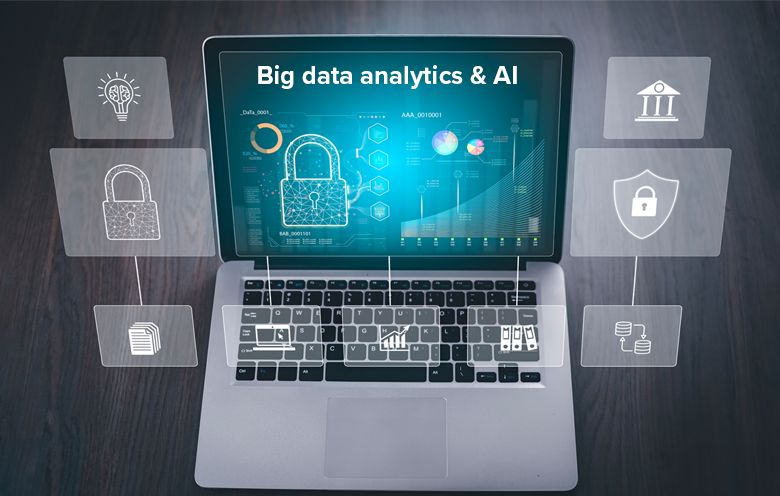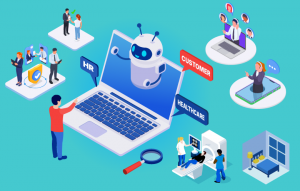The digital age is awash in data. The amount of information organizations collect is growing exponentially, creating a vast data repository with immense potential. This data goldmine holds the key to not only understanding customers but also fortifying security.
A recent Forrester survey found that 37% of organizations named “improved customer insights and better customer experience delivery” as the top benefit of leveraging data and analytics.
Artificial intelligence (AI) is emerging as a powerful tool to unlock the true potential of big data for security purposes. However, this powerful marriage also presents challenges that require careful consideration. Let’s explore the benefits and drawbacks of integrating big data analytics and AI for enhanced security.
Benefits of big data analytics and AI
Enhanced decision making:
Security analysts are traditionally tasked with manually sifting through vast quantities of security logs. This process can be time-consuming and error prone. Artificial intelligence, however, can efficiently analyze not only logs, but also network traffic, user behavior, and threat intelligence feeds – all in a comprehensive and simultaneous manner.
Companies that have implemented AI have had a 37% reduction in errors in decision making – Gartner
By identifying subtle connections between seemingly disparate events, AI can uncover potential threats that might evade traditional security analysis. This empowers security teams to:
- Prioritize threats effectively: Identify and focus on the most critical threats based on real-time analysis, ensuring resources are directed towards the biggest risks.
- Predict attacks before they happen: AI can learn from past attacks and identify patterns that indicate future threats. This allows security teams to take preventative measures and mitigate risks before they escalate.
- Uncover underlying trends: By analyzing vast data sets, AI can reveal hidden trends and vulnerabilities in an organization’s security posture. This allows for proactive security planning and resource allocation.
Improved efficiency
Security teams are often overwhelmed with manual tasks like log analysis, threat detection, and incident response. AI can automate these routine tasks, freeing up security personnel to focus on higher-level activities. This can lead to:
- Reduced workload: Security analysts can spend less time on repetitive tasks and more time on strategic planning, investigations, and threat hunting.
- Faster response times: Automated threat detection allows for quicker response to security incidents, minimizing potential damage.
A study by McKinsey estimated that AI could automate up to 45% of cybersecurity tasks.
- Improved productivity: With AI handling routine tasks, security teams can be more productive and efficient in their overall operations.
Accelerated innovation:
Traditional security approaches often struggle to keep pace with evolving threats. AI, however, is constantly learning and improving. By analyzing past security incidents and attack patterns, AI systems can:
- Adapt to new threats: AI can identify and learn from new attack methods, allowing security systems to adapt and evolve to stay ahead of emerging threats.
- Develop new security strategies: By constantly analyzing data and implementing AI strategies, companies can discover new security vulnerabilities and suggest proactive measures to address them.
69% of organizations use AI or machine learning for fraud detection and prevention. – Deloitte
- Foster a proactive security culture: The focus on continuous learning and adaptation encourages a proactive approach to security, where prevention takes center stage.
Data security and privacy:
- Data anonymization: AI can be used to anonymize sensitive data while still extracting valuable insights for security purposes. This helps organizations comply with data privacy regulations and maintain user trust.
- Threat detection for insider threats: AI can analyze user behavior patterns to identify potential insider threats, protecting sensitive data from unauthorized access or misuse.
A study by Capgemini found that organizations using AI in their cybersecurity strategies experienced a 12% improvement in the detection and response to threats.
- Improved access control: AI can be used to create more sophisticated access control systems that learn user behavior and adapt access privileges accordingly, reducing the risk of unauthorized access to sensitive data.
Suggested: AI and data analytics in sports
Challenges of big data analytics and AI in security and how to address them
Data privacy concerns:
Collecting and analyzing vast amounts of data raises legitimate concerns about user privacy. Here’s how these concerns can be addressed:
- Transparency and user consent: Organizations must be transparent about the data they collect, how it is used, and with whom it is shared. Users should have clear and easy-to-understand options regarding data collection and usage.
- Data anonymization techniques: Implementing robust anonymization techniques can ensure that valuable insights are extracted from data without compromising user privacy.
Cybersecurity threats:
AI systems themselves can be vulnerable to hacking or manipulation. Here’s how to mitigate these risks:
- Security by design: AI systems should be built with security in mind from the very beginning. This includes incorporating secure coding practices, regular vulnerability assessments, and penetration testing.
- Continuous monitoring: Security teams need to continuously monitor AI systems for suspicious activity and potential vulnerabilities.
Complexity management:
Integrating big data, AI, and security requires robust infrastructure and skilled personnel. Here’s how to navigate this complexity:
- Scalable infrastructure: Investing in a scalable and secure infrastructure is crucial to handle the demands of big data analytics and AI.
- Developing expertise: Organizations need to build internal expertise in data science, AI, and security to manage these complex systems effectively.
Regulatory compliance:
The regulatory landscape surrounding data privacy and AI is constantly evolving. Here’s how to stay compliant:
- Staying informed: Organizations need to stay up to date on evolving data privacy regulations like GDPR and CCPA.
- Compliance audits: Regularly conducting compliance audits ensures adherence to data privacy regulations.
Leverage the combinational power of big data analytics and AI
The convergence of big data analytics and artificial intelligence presents a paradigm shift in the security landscape. By leveraging data analytics services to harness the power of big data, organizations can gain significant advantages. However, this powerful combination is not without its challenges. Careful consideration must be given to data privacy concerns, cybersecurity risks, and regulatory compliance.
By implementing robust security measures and prioritizing responsible data practices, organizations can unlock the true potential of big data and AI to build a more secure and resilient future. Contact our data and AI experts to better understand our data analytics services.









